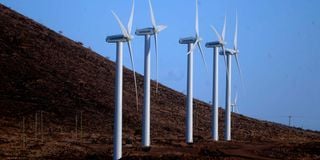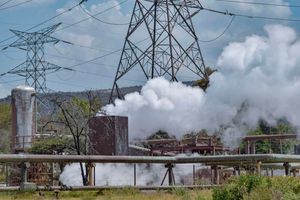Wind power: Lessons from Denmark

The Turbines of the 310MW Lake Turkana Wind Power project in Laisamis Constituency, Marsabit County on February 7, 2019.
What you need to know:
- Denmark is the largest exporter of wind turbine technology.
- Here, nearly every major university has a department focused on research in renewable energy, with Aarhus, Aalborg, Technical University of Denmark and University of Copenhagen all offering renewable energy engineering programmes.
From mainland Denmark to the islands of Samsø and Jutland, off the coast of the North Sea and in the Baltic Sea, the Danish landscape and skyline are dominated by wind turbines that crop up on every open space. In this Nordic country, wind farms are nearly as common as crop farms.
Samsø, an idyllic island southwest of Copenhagen, has over the last 20 years been the model of green energy. So ingrained is green energy on the island that even the local municipality operates only electric vehicles. In 2021, the island was the recipient of the UN Global Climate Action Award for its investment and adoption of clean energy.
Here, farmers here have been scaling down pig and dairy farming to put up wind farms that now dot their land. Where cattle paddocks existed before, giant wind turbines tower above wheat and hay farms and the smattering of chestnut and auburn farmhouses, creating a picturesque atmosphere that stretches for tens of miles.
Other farmers have completely abandoned parsley, potato and wheat farming that have traditionally been the island’s mainstay to concentrate resources on wind farming. For a good reason. Farmers such as Jørgen Tranberg now farm a different type of ‘crop’ for a living: wind. Tranberg owns several turbines and solar PV to power his farm.
He now sells power to the government. “I earn about 2.5 million euros (Sh370 million) per year,” he tells Healthy Nation.
At 14 per cent of its total energy mix, Denmark is the runaway leader in wind power in the world. The country is also the largest producer of wind power in the world at 50 per cent.
In Denmark, nearly every major university has a department focused on research in renewable energy, with Aarhus, Aalborg, Technical University of Denmark and University of Copenhagen all offering renewable energy engineering programmes.
Besides universities, Denmark has multiple renewable energy companies including State of Green, Orsted, COWI, Steeper Energy, Vestas and Danish Renewables. Some of these have a global footprint, providing power solutions around the world.
But how did Denmark become a leader in green energy?
Aarhus University researcher Henrik Pedersen says the country had to pivot after the oil crisis and steep price fluctuations of the 1970s that left millions of Danish homes in the cold and dark.
An attempt to end reliance on oil imports would mark the genesis of multibillion investments, making Denmark one of the most energy independent countries in the world today.
Denmark’s dalliance with wind power technology had begun much earlier, though, with the world’s first wind turbine made in the country in 1891 by Poul La Cour, a professor of natural science at the Askov Folk High School.
The fairytale would continue into the 20th century when, together with the US, Denmark invested millions of euros in research and testing of the technology.
Pedersen describes wind turbines as an attractive business for farmers. “Farmers do not receive financial incentives today although in the past the government guaranteed minimum feed-in-tariffs. Most of the new wind farms operate on commercial market-based conditions,” says the researcher at the department of physics and astronomy at Aarhus University.
In Denmark, wind farm owners only pay a fee to get licences to put up wind turbines in offshore areas and are required to pay income tax from their earnings.
Constructed at a staggering cost of Sh70 billion, with 365 wind turbines on a 40,000-acre expanse, Lake Turkana Wind Project is easily the most notable wind project in Kenya’s history. Launched in 2017 with fanfare and the promise to power one million homes, the project has, however, failed to live up to its billing.
Margrethe Andersen, a Danish renewable expert and entrepreneur, explains that the transmission line was not ready by the time the LTWP was ready to start producing electricity.
“This meant that LTWP was entitled to some payment until the transmission line from the project site to the main grid was ready. The costs are borne by consumers, making the price of electricity higher than it would otherwise have been.”
With wind, solar, hydro and geothermal power, which constitute 92 per cent of the energy mix in the country, energy experts believe that Kenya is on a solid path to transitioning to clean energy. Even so, the prices have yet to come down to levels affordable by the general population, a situation that has prevented large-scale deployment of renewables in Kenya.
“Nearly all of the costs for renewables lie in the upfront costs to build the necessary infrastructure,” explains Mohamed Adow, a renewable energy expert and founder of PowerShift Africa.
Mohamed argues that a renewable energy revolution in Kenya would require the establishment of strong public policies that not only generate investments but protect them as well. “Policies create safe and predictable long-term investment conditions that are key to the recovery of the initial cost incurred.”
To Klaus Christensen, Kenya cannot continue to push under the rug calls to liberalise the energy industry, arguing that this would enhance efficiency.
The East Africa manager of the Danish Confederation of Industry insists that private utilities must be allowed to enter the fray to generate and supply power, adding: “Having more players in power generation and supply means competition. This would also effectively drive down power rates.”
“The government must also commit to buying power from private citizens who produce the utility. It must also commit to paying them for their contribution to the grid,’’ he adds.
Andersen agrees, saying Kenya could gain by utilising linkages between on and off-grid power production.
“There is need to collaborate with other countries in developing sound strategies for making new renewable energy projects economically viable.”
Foremost, Kenya must address its ineffective power transmission infrastructure, Klaus says. ‘‘The country has only one power supply line, making it vulnerable to any fault along the line. There needs to be a backup power plan in case of accidents.”
There is, however, more to clean energy than powering the country, Margrethe argues. “Renewable energy projects may help to develop capabilities in innovation and production that are crucial to Kenya’s future.’’
To her, Danish investors benefit from a flexible policy that has led to a higher percentage of renewable energy, including solar, wind and biomass feeding into the grid. Kenya, the researcher says, could benefit from this approach as well, adding, though, that there are many setbacks.
“Many actors in Kenya are currently going off-grid and developing their own energy supply systems based on renewables. In Denmark, such systems are mostly connected to the grid. This ensures production of more energy for the country’s needs and even for export,’’ she explains.
Denmark experiences surplus production during some of the windiest months, forcing it to offload on its neighbours. ‘‘There are ongoing efforts to develop better storage facilities so we can preserve the surplus energy for later use rather than exporting it.’’
Pedersen notes that it is cheaper and safer to invest in wind energy than to expand fossil fuel-based energy forms. “Green energy is well-suited for local grids, especially those unconnected to the national grid. This is scalable and does not require continuous fuel input.’’
But to bring down the cost of installation further, Klaus says skill development is critical, adding that the high cost of off-grid power installation in Kenya is partly the result of fewer people with technical expertise. ‘‘Having more solar panel installers would significantly lower the cost,’’ he says.
"It is unfortunate that Kenyans still experience power cuts when there is so much of it produced in the country. Kenya could attain 100 per cent renewables by harnessing its geothermal potential and put the intermittent supply of power behind its back,’’ Klaus says.





